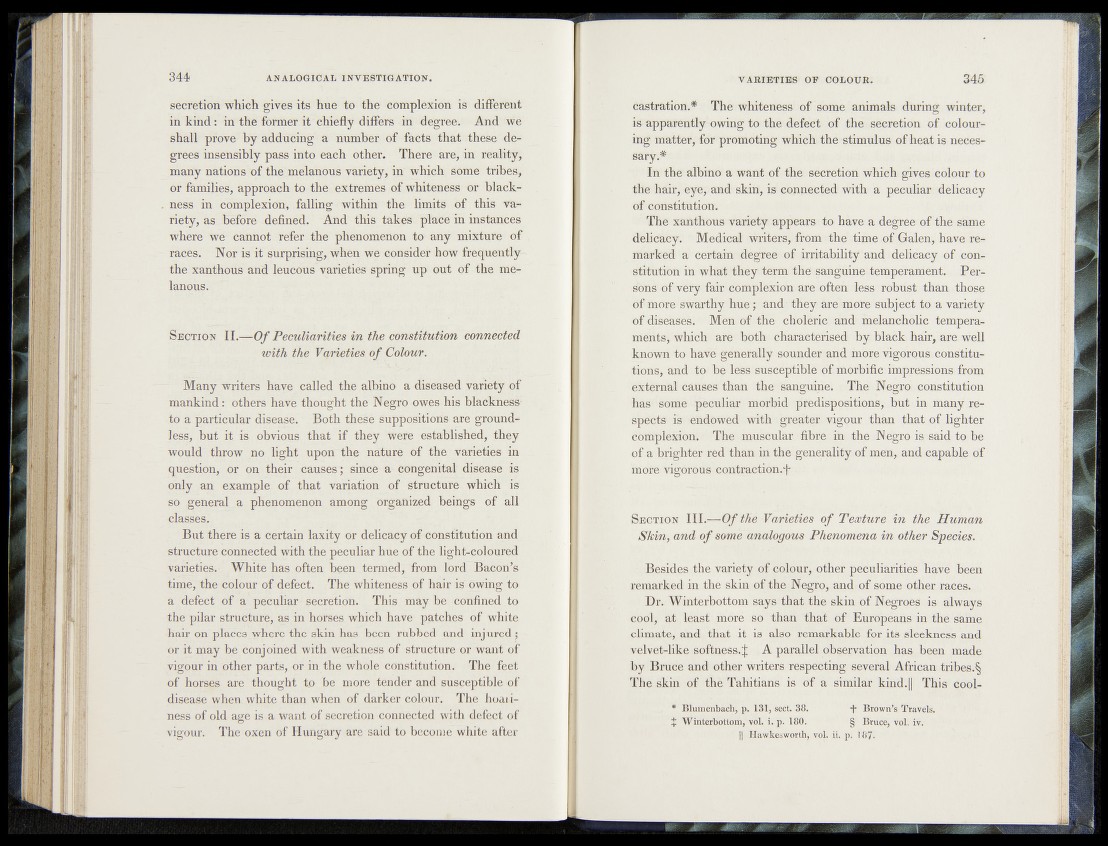
secretion which gives its hue to the complexion is different
in kind: in the former it chiefly differs in degree. And we
shall prove by adducing a number of facts that these-degrees
insensibly pass into each other. There are, in reality,
many nations of the melanous variety, in which some tribes>
or families, approach to the extremes of whiteness or blackness
in complexion, falling within the Emits of this va-
riety, as before defined. And this takes place in instances
where we cannot refer the phenomenon to any mixture of
races. Nor is it surprising, when we consider how frequently'
the xanthous and leucous varieties spring up out of the melanous.
’
S ection II.— O f Peculiarities in the constitution connected
with the Varieties o f Colour.
Many writers have called the albino a diseased variety of
mankind: others have thought the Negro owes his blackness
to a particular disease. Both these Suppositions are groundless,
but it is obvious that if they were established, they
would throw no light upon the nature of the varieties in
question, or on their causes^ since a- congenital disease is
only an example of that variation of Structure which*’is
so .general a phenomenon among organized beings of all
classes.
But there is a certain laxity or deHcacy of constitution and
structure connected with the peculiar hue of the light-coloured
varieties.- White has often been termed, from lord Bacon’s
time, the colour of defect. The whiteness of hair is' owing to
a defect of a peculiar secretion. This may be confined to
the pilar structure, as in horses which have patches of white
•hair on places where the skin has been rubbed and injured;
or it may be conjoined with weakness of structure or want of
vigour in other parts, or in the whole constitution. The feet
of horses are thought t.o be more tender and susceptible of
disease when white than when of darker colour. The hoariness
of old age is a Want of secretion connected with defect of
vigour. The oxen of Hungary are said to become white after
castration.* The whiteness of some animals during winter,
is apparently-owing to the defect of the secretion of colouring
matter, for promoting which the -stimulus of heat is necessary.*
In the albino a want of the secretion which gives colour to
the hair, eye, and skin, is connected with a pecuHar delicacy
of constitution.
The xanthous variety appears to have a degree of the same
delicacy. Medical writers, from the time of Galen, have remarked
a certain ^ degree of irritability and delicacy of constitution
in what they' term thd sanguine temperament. Persons
of very fair complexion are often less robust than those
of More swarthy h u e ; and they are more subject to a variety
of diseases; Men of the choleric and melancholic temperaments,
which are both characterised by black, hair, are well
known to have generally sounder,’and more vigorous constitutions,
and to''be leSslf'suseeptible of morbific} impressions from
external causes than the sanguine. The Negro constitution
has some peculiar morbid predispositions, but in ,many respects
is endowed with '..greater..-vigour than that of lighter
Complexion. The muscular*gfibre * in the N egro is said to be
of a brighter red than in the. generality, of men,mnd capable of
more vigorous contraction.^*
Section I I I .— O f the Varieties o f Texture in the Human
Sk in, and o f some analogous Phenomena in other Species.
Besides the variety of colour, other peculiarities have been
remarked in the skin of the Negro, and of some other races.
Dr. Winterbottom says that the skin of Negroes is always
cool, at least more so than that of Europeans in the same
chmate, and that it is also remarkable for its sleekness and
velvet-like softness.^ A parallel observation has been made
by Bruce and other writers respecting several- African tribes.§
The skin of the Tahitians is of a similar kind.|| This cool-
* Blumenbach, p. 131, sect. 38. -J* Brown’s Travels.
X Winterbottom, vol. i, p. 180. § Bruce, vol. iv.
■ |.| Hawkesworth, vol, ii. p. 187.